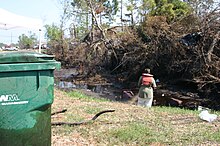Murphy Oil USA refinery spill: Difference between revisions
+reformat |
m sp |
||
| Line 1: | Line 1: | ||
According to US Coast Guard there were about 44 oil spills in the area affected by Hurricane Katrina. Most of these |
According to US Coast Guard there were about 44 oil spills in the area affected by Hurricane Katrina. Most of these occurred in areas of [[Plaquemines Parish]] which do not have large populations. The exception is the '''[[Murphy Oil]] Spill''' which hit residential areas of [[Chalmette, Louisiana]] and [[Meraux, Louisiana]]. |
||
[[Image:Murphy_Oil_Meraux_Tank_Breech.jpg|right|thumbnail|The rupture in the tank can clearly be seen in this EPA photograph.]] On August 30, 2005, the |
[[Image:Murphy_Oil_Meraux_Tank_Breech.jpg|right|thumbnail|The rupture in the tank can clearly be seen in this EPA photograph.]] On August 30, 2005, the storm surge from Hurricane Katrina caused massive failure along the [[Mississippi River Gulf Outlet]] levee and inundated [[St. Bernard Parish]] 4 to 14 feet of water. Murphy Oil refinery was under approximately 9 feet of water. A 250,000 barrel above ground storage tank was dislodged, lifted and damaged in flooding associated. The tank contained 65,000 barrels of mixed crude oil, and released approximately 25,110 barrels (1,050,000 gallons). The pressure from the flood waters kept the water inside of the tank until the waters had receded to about 4 feet. As the oil released it flowed along with the flood waters from east to west. The released oil impacted approximately 1700 homes in an adjacent residential neighborhoods of Chalmette; an area of about one square mile. Several canals have also been impacted: the 20 Arpent Canal; the 40 Arpent Canal; the Meraux Canal; the Corinne Canal; the DeLaRonde Canal; and, various unnamed interceptor canals. [http://www.epa.gov/katrina/testreslts/murphy/] |
||
===Criticism of Murphy Oil=== |
===Criticism of Murphy Oil=== |
||
Revision as of 21:57, 17 May 2006
According to US Coast Guard there were about 44 oil spills in the area affected by Hurricane Katrina. Most of these occurred in areas of Plaquemines Parish which do not have large populations. The exception is the Murphy Oil Spill which hit residential areas of Chalmette, Louisiana and Meraux, Louisiana.

On August 30, 2005, the storm surge from Hurricane Katrina caused massive failure along the Mississippi River Gulf Outlet levee and inundated St. Bernard Parish 4 to 14 feet of water. Murphy Oil refinery was under approximately 9 feet of water. A 250,000 barrel above ground storage tank was dislodged, lifted and damaged in flooding associated. The tank contained 65,000 barrels of mixed crude oil, and released approximately 25,110 barrels (1,050,000 gallons). The pressure from the flood waters kept the water inside of the tank until the waters had receded to about 4 feet. As the oil released it flowed along with the flood waters from east to west. The released oil impacted approximately 1700 homes in an adjacent residential neighborhoods of Chalmette; an area of about one square mile. Several canals have also been impacted: the 20 Arpent Canal; the 40 Arpent Canal; the Meraux Canal; the Corinne Canal; the DeLaRonde Canal; and, various unnamed interceptor canals. [1]
Criticism of Murphy Oil

Major industries in St. Bernard Parish, including the three oil refineries, had disaster mitigations plans that were filed with the local government. However, the local government lost most of its files in the flood that followed the levee failure. Murphy Oil has refused to release a copy of their disaster mitigation plans and refuses to comment on the level of the oil in the tank at the time of the flood or whether or not the tank was filled with water at the time of the storm.
Employees of oil refineries in the disaster area have stated on online forums that their refineries filled tanks with water in order to prevent them from floating away. Another refinery employee commented that these large oil storage tanks are sometimes purposely floated in order to move them. The containment levees around the tank are generally filled with water and tanks are moved in this way around tanks farms.
The state of Hawaii has recommended a similar emergency mitigation plan in a Hawaii Energy Strategy Report from 2000:
Use water fill to protect petroleum storage tanks.
Results. This recommendation is intended to help protect tanks from storm surge, which could cause tanks to float off their bases.
The Chevron Hawaii Refinery reported that it has developed specific procedures for tropical storm and hurricane preparedness as part of its Emergency Plans and Procedures. Water fill is used to completely fill fresh water tanks in the refinery ahead of an emergency. Chevron's petroleum tanks are designed and located on elevated platforms, within bermed enclosures, so that the tank bottoms are above storm surge levels. This design prevents the tanks from floating off their bases and precludes the need to use water fill. Water fill may still be appropriate for lower level tanks (Simons 1999) [2]
